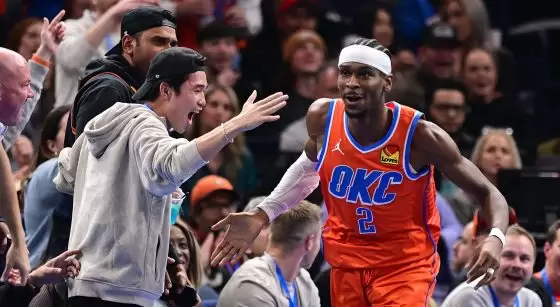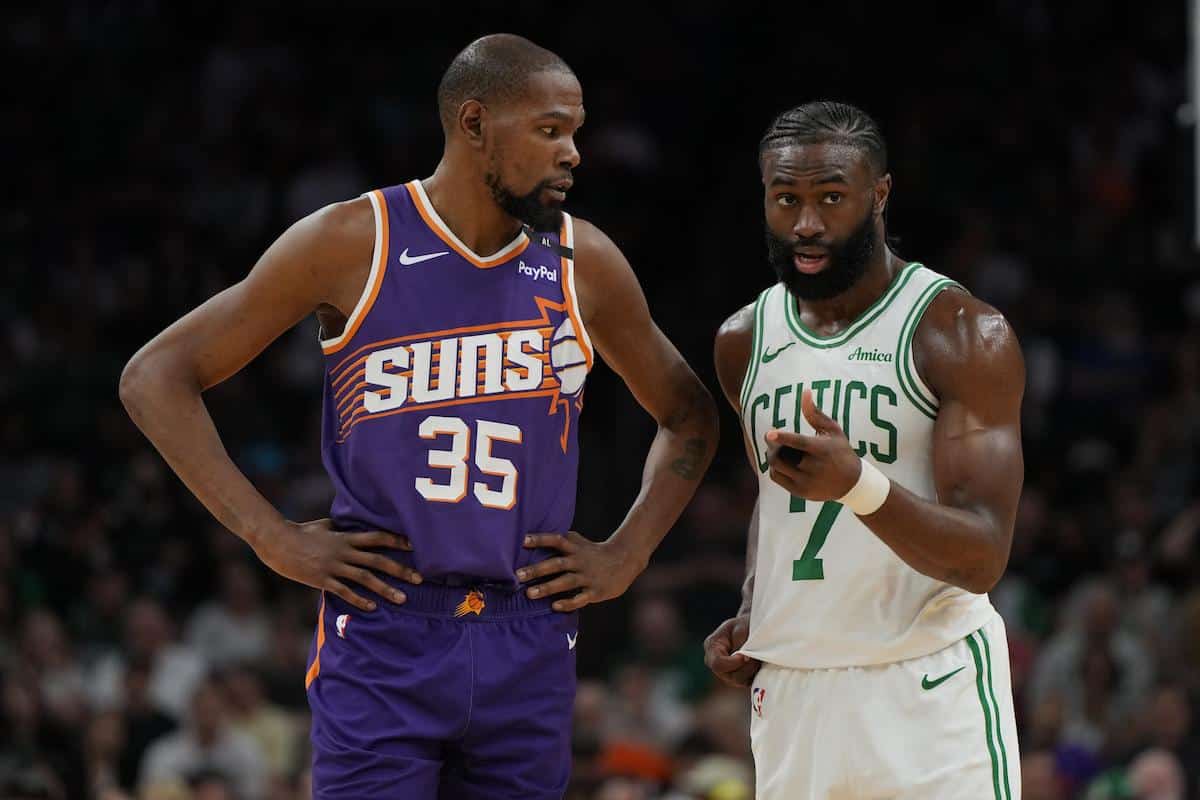The Boston Celtics faced off against the Washington Wizards in the second night of a back-to-back Summer League schedule. Despite some solid flashes, Boston came up short for the second straight game. This is Summer League, though. Every minute played is about developing, learning, and assessing.
Let’s dive into today’s 10 takeaways.
#1 Lots of zone
Shoutout to Green With Envy’s Will Weir – he floated this question on today’s podcast: “with a new coaching staff on the bench bringing fresh ideas, are we seeing a prelude to the regular season with how much zone the Summer League Celtics are playing?”
We’re not going to know the answer to that question right now. However, there’s a chance we could see Boston deploy more zone next season, and there’s a chance they won’t. Either way, SL head coach Tony Dobbins had his team rolling out 2-3 zone defense for significant stretches of the game.
To Boston’s credit, their zone defense was successful in disrupting the Wizards’ half-court offense and led to multiple disjointed possessions. Having either Olek Balcerowksi or Udoka Azubuike in the middle of the zone also ensured the Celtics had some size protecting the rim. Dobbins sprinkled some 2-3 and 1-3-1 zone into Boston’s Summer League opener against the Miami Heat on Saturday, but nowhere near this level of frequency.
We will need to wait until Wednesday before we see whether Dobbins continues to stick with his zone defense principles.
#2 A big improvement from Justin Champagnie
Against the Heat, Justin Champagnie felt like a passenger. Rarely did the third-year wing make much of an impact. Fast forward 24 hours, and Champagnie flashed the upside and dominance that you would expect from one of the more experienced members on the floor.
Champagnie’s best skill is as a rebounder. Yet, in the fourth quarter, the 22-year-old came alive as a scorer, dropping 10 points to help the Celtics try and close the gap. Champagnie also ended the contest as the highest scorer in the game and the only player to register a double-double.
What’s more, Champagnie also flashed some upside as a secondary creator with a couple of touch passes around the low post to punish defensive rotations and find the open big.
There are still some questions surrounding Champagnie’s defense that need answering, but this is Summer League — the pace is frantic, everybody wants to impress, and the defense often stutters as a result. All-in-all, this was a solid bounce-back game for Champagnie, who will need to string some more of these performances together if he wants to fight for his contract guarantee.
#3 You need a bucket if you’re going to Scrubb something
Honestly, Jay Scrubb has been my favorite player in the Celtics Summer League throughout the first two games. When he’s on the court, Scrubb is a bucket. There’s no telling how his scoring would translate to the NBA level where he would face a higher caliber of defender and athlete, but Scrubb gives off all the feels of a microwave scorer off the bench.
Against the Wizards, Scrubb continued to show his array of scoring moves while also proving to be a capable three-level threat. Yet, the thing that impressed me the most was seeing Scrubb score out of a pick-and-roll action where he was the ball-handler.
Summer League success, especially on the offensive end, isn’t something we should be reading too deeply into. Scrubb is fun to watch and can definitely get you buckets. Can he do it consistently when playing at the next level? Or is he destined for another two-way deal? A lot will depend on how he handles defensive responsibilities, and that’s something we’ve not seen much of from him in the opening two games.
#4 Tony Dobbins at the wheel
Late in the third quarter, the Celtics went deep into their playbook archives to run a ‘wheel’ action.
Not much to take away here. I just liked seeing it being called and thought it was worth pointing out. For reference, the Celtics ran these actions under Ime Udoka and often found good scoring opportunities from them.
#5 Knee-ding more from Jordan Walsh
In the opening minutes of Boston’s game against Washington, Jordan Walsh suffered a knee clash as he guarded a cross-action. From that moment on, Walsh seemed a step slower than what we saw against Miami, and his scoring ability evaporated. Walsh went 4-of-14 from the field and 1-of-6 from three, which is more aligned with what most of us expected from the second-round draft pick before he shocked us in Boston’s opening game hitting his four threes.
Walsh didn’t let his offensive struggles slow him down, though. Instead, the Arkansas product remained active on defense and used his length to be a disruptive force. Hopefully, Walsh’s knee isn’t too bad, and he will be good to go on Wednesday.
Part of being a rookie is lacking consistency. So, Walsh’s performance, however, restricted by his knee, isn’t something to panic about. Growing pains will also occur during a player’s first couple of years.
#6 Olek Balcerowksi needs to use his size more
On the whole, Balcerowksi had a good game against Washington. The big man was a willing screener, showed his mobility on both sides of the floor, and his a one-footed fadeaway from the corner to ice the opening quarter. However, at 7’1’’, Balcerowksi has no excuse for not being more dominant on the glass.
Rebounding wasn’t part of Balcerowksi’s game for Gran Canaria last season, something which I put down to the defensive scheme he played in. However, Dobbins has used Balcerowksi as the big man in a 2-3 zone and a dropping defender. When Balcerowski has played his man higher up the floor, he’s remained below the level of the screen. We need to see Balcerowksi show more aggressiveness when challenging for rebounds and making better use of his big frame.
On the plus side, Balcerowksi did show some upside as a screener.
#7 Flashes of ball movement
Summer League is an individualistic tournament. Everybody is playing for their own chances of making a roster, earning a training camp invite, or impressing overseas scouts that are in attendance. Boston seemed to put those individualistic agendas to one side for multiple possessions throughout the game against the Wizards.
A flare screen for Justin Bean. A reset to Jordan Walsh. High entry pass. Back cut. Dunk. Good spacing, good off-ball movement, and fluidity to the Celtics’ approach. Possessions like these will tell you a lot more about the players on the floor than any highlight play or poster dunk.
#8 Justin Bean
Two games in, and Justin Bean hasn’t done anything to stand out. Bean also hasn’t done anything to hurt his stock. Instead, Bean looks to be exactly what you want from a role player — dependable. Slotting into the team’s offensive and defensive scheme, Bean is playing his role and holding his own.
We’ve also seen moments of scoring that indicate Bean can hurt you from all three levels.
The only question I would have about Justin Bean at this point, is whether he will be a step or two too slow to be an effective member of an NBA rotation.
#9 Udoka Azubuike had a better game
Azubuike struggled against the Miami Heat but found more success against the Wizards. The Celtics looked to feed Azubuike at times as they sought to make use of his size down low. Unfortunately, the former Utah Jazz big still appeared to be a poor screener and isn’t dominant on the low block despite not possessing a shot from outside of the restricted area.
Azubuike can rebound, though, and has the size to be a shot deterrent when guarding as a drop defender or in the middle of a zone defense.
#10 Two-Way JD Davison
J.D. Davison came into the game against Washington fresh off signing a second two-way contract with the Celtics. However, it was a night to forget for the second-year guard. Davison showed the same limitations that we saw against Miami: he struggles when faced with contact and doesn’t have the consistent aggression required to make the most out of his penetration ability.
Davison would thrive alongside a lob threat. Davison needs more to his game than just speed and lob passing. We need to see the two-way guard embracing finishing through contact. We need to see Davison drawing more defensive attention before kicking the ball out. And Davison needs to improve his ability to score off the dribble.
There’s a lot to like about what Davison brings to the court, and he’s clearly improved since this time last year. Unfortunately, there appears to be a long way to go before Davison begins to make good on his potential. The physical tools are there, now the skills need to continue being refined.






